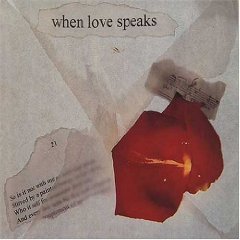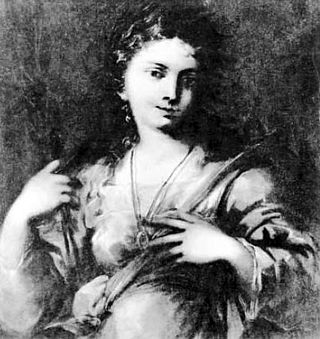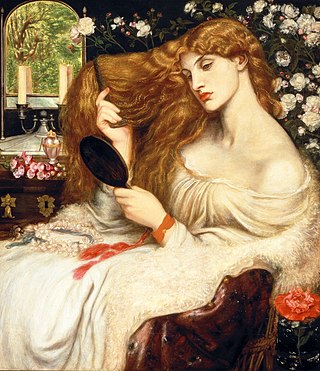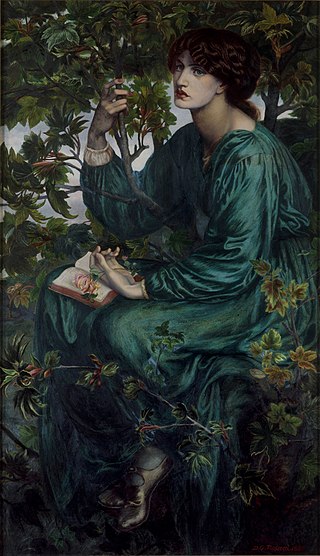
Gabriel Charles Dante Rossetti, generally known as Dante Gabriel Rossetti, was an English poet, illustrator, painter, translator, and member of the Rossetti family. He founded the Pre-Raphaelite Brotherhood in 1848 with William Holman Hunt and John Everett Millais. Rossetti inspired the next generation of artists and writers, William Morris and Edward Burne-Jones in particular. His work also influenced the European Symbolists and was a major precursor of the Aesthetic movement.

Christina Georgina Rossetti was an English writer of romantic, devotional and children's poems, including "Goblin Market" and "Remember". She also wrote the words of two Christmas carols well known in Britain: "In the Bleak Midwinter", later set by Gustav Holst, Katherine Kennicott Davis, and Harold Darke, and "Love Came Down at Christmas", also set by Darke and other composers. She was a sister of the artist and poet Dante Gabriel Rossetti and features in several of his paintings.

William Shakespeare (1564–1616) wrote sonnets on a variety of themes. When discussing or referring to Shakespeare's sonnets, it is almost always a reference to the 154 sonnets that were first published all together in a quarto in 1609. However, there are six additional sonnets that Shakespeare wrote and included in the plays Romeo and Juliet, Henry V and Love's Labour's Lost. There is also a partial sonnet found in the play Edward III.

The Serenade for Tenor, Horn and Strings, Op. 31, is a song cycle written in 1943 by Benjamin Britten for tenor, solo horn and a string orchestra. Composed during the Second World War at the request of the horn player Dennis Brain, it is a setting of a selection of six poems by English poets on the subject of night, including both its calm and its sinister aspects. The poets Britten chose to set for the Serenade range from an anonymous 15th-century writer to poets from the 17th, 18th and 19th centuries.
Thomson William "Thom" Gunn was an English poet who was praised for his early verses in England, where he was associated with The Movement, and his later poetry in America, even after moving towards a looser, free-verse style. Gunn wrote about his experience moving to San Francisco from England. He received numerous literary honors, and his best poems are reputed to possess a restrained elegance of philosophy.

Sonnet 30 is one of the 154 sonnets written by the English poet and playwright William Shakespeare. It was published in the Quarto in 1609. It is also part of the Fair Youth portion of the Shakespeare Sonnet collection where he writes about his affection for an unknown young man. While it is not known exactly when Sonnet 30 was written, most scholars agree that it was written between 1595 and 1600. It is written in Shakespearean form, comprising fourteen lines of iambic pentameter, divided into three quatrains and a couplet.

Sonnet 13 is one of 154 sonnets written by the English playwright and poet William Shakespeare. It is a procreation sonnet within the Fair Youth sequence.

Sonnet 22 is one of 154 sonnets written by the English playwright and poet William Shakespeare, and is a part of the Fair Youth sequence.

Sonnet 36 is one of 154 Shakespeare's sonnets written by the English playwright and poet William Shakespeare. It's a member of the Fair Youth sequence, in which the speaker expresses his love towards a young man.

Sonnet 42 is one of 154 sonnets written by the English playwright and poet William Shakespeare. It is a part of the Fair Youth section of the sonnets addressed to an unnamed young man.

A Vision of Fiammetta is an oil painting created by Dante Gabriel Rossetti, in the Pre-Raphaelite style, created in 1878. The painting was one half of one of Rossetti's "double works", accompanying his Ballads and Sonnets (1881). Maria Spartali Stillman modelled for the painting. The subject of painting is Boccaccio's muse named Fiammetta.

Sonnet 78 is one of 154 sonnets published by the English playwright and poet William Shakespeare in 1609. It is one of the Fair Youth sequence, and the first of the mini-sequence known as the Rival Poet sonnets, thought to be composed some time from 1598 to 1600.
Sonnet 101 is one of 154 sonnets written by the English playwright and poet William Shakespeare. It is a member of the Fair Youth sequence, in which the poet expresses his love towards a young man. The three other internal sequences include the procreation sonnets (1–17), the Rival Poet sequence (78–86) and the Dark Lady sequence (127–154). While the exact date of composition of Sonnet 101 is unknown, scholars generally agree that the group of Sonnets 61–103 was written mainly in the first half of the 1590s and was not revised before being published with the complete sequence of sonnets in the 1609 Quarto.

When Love Speaks is a compilation album that features interpretations of William Shakespeare's sonnets – some spoken, some set to music – and excerpts from his plays by famous actors and musicians, released under EMI Classics in April 2002. The original idea came from Joy Gelardi who proposed the album as a fund raiser for Shakespeare’s Globe Theatre. When that plan fell through, Joy and Michael Kamen, together with Alan Rickman, co-produced it in support of RADA. Alan chose the title, which alludes to a speech in Love's Labour's Lost – "And when love speaks, the voice of all the gods make heaven drowsy with the harmony." – which is, however, not on the album.

Sarra Copia Sullam (1592–1641) was an Italian poet and writer who lived in Italy in the late 16th and early 17th centuries. She was Jewish and very well educated. Despite being married, for many years she had what appears to have been an extremely close relationship, by correspondence only, with a writer, Ansaldo Cebà, whom she admired but whom she never actually met. He was a Christian, and at that point in his life he had become a monk. He appears to have fallen in love with Sarra, and constantly urged her to convert to Christianity, but she resisted.

Lady Lilith is an oil painting by Dante Gabriel Rossetti first painted in 1866–1868 using his mistress Fanny Cornforth as the model, then altered in 1872–73 to show the face of Alexa Wilding. The subject is Lilith, who was, according to ancient Judaic myth, "the first wife of Adam" and is associated with the seduction of men and the murder of children. She is shown as a "powerful and evil temptress" and as "an iconic, Amazon-like female with long, flowing hair."

Found is an unfinished oil painting by Dante Gabriel Rossetti, now in the Delaware Art Museum. The painting is Rossetti's only treatment in oil of a contemporary moral subject, urban prostitution, and although the work remained incomplete at Rossetti's death in 1882, he always considered it one of his most important works, returning to it many times from the mid-1850s until the year before his death.

Proserpine is an oil painting on canvas by English artist and poet Dante Gabriel Rossetti, painted in 1874 and now in Tate Britain. Rossetti began work on the painting in 1871 and painted at least eight separate versions, the last only completed in 1882, the year of his death. Early versions were promised to Charles Augustus Howell. The painting discussed in this article is the so-called seventh version commissioned by Frederick Richards Leyland, now at the Tate Gallery, with the very similar final version now at the Birmingham Museum and Art Gallery.

The Day Dream or, as it was initially intended to be named, Monna Primavera, is an oil-on-canvas painting by the Pre-Raphaelite Brotherhood founder member Dante Gabriel Rossetti. The work, which measures 158.7 centimetres (62.5 in) high by 92.7 centimetres (36.5 in) wide, was undertaken in 1880 and depicts Jane Morris in a seated position on the bough of a sycamore tree. In her hand is a small stem of honeysuckle – a token of love in the Victorian era – that may be an indication of the secret affair the artist was immersed in with her at the time. The artwork was left to the Victoria and Albert Museum by Constantine Alexander Ionides in 1900.

Venus Verticordia (1864–1868) by Dante Gabriel Rossetti is a semi-nude depiction of the goddess Venus, portrayed as a young woman with a golden halo and flowing auburn hair, surrounded by pink flowers in a dark, lush green garden. Her left breast is visible, while the right is obscured by the golden apple she holds in her left hand. In her right hand she holds an arrow, the point directed towards her own heart, and on which rests a small yellow butterfly. Other similar butterflies ring the halo surrounding her head, and another sits on top of the apple she holds.



















